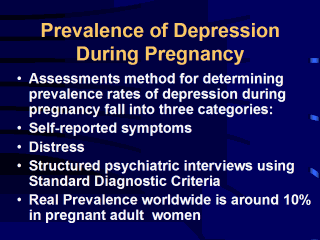| front |1 |2 |3 |4 |5 |6 |7 |8 |9 |10 |11 |12 |13 |14 |15 |16 |17 |18 |19 |20 |21 |22 |23 |24 |25 |26 |27 |28 |29 |30 |review |
 |
Self-reported
Symptoms: rates of self-reported depressive symptoms vary from
population to population. In some groups it may be as high as 51% for adult
populations and the ranges is 16-44% in adolescent pregnant populations. Distress: The rates of distress also vary across populations. Forty-two percent of an Indian population reported distress during pregnancy as measured by the General Health Questionnaire (Patel V, Rodrigues M, DeSouza N (2002). Gender, poverty, and postnatal depression: a study of mothers in Goa India. American Journal of Psychaitry 159:43-47. In a population from the United Kingdom about 10% report distress during the first trimester and 15% in the second and third trimesters. Kumar R, Robson KM (1984). A prospective study of emotional disorders in childbearing women. British Journal of Psychiatry 144:35-47.In a Danish population, the rate of distress during the third trimester is similar to the rate in the United Kingdom using the same instrument to assess distress. The rate for third trimester distress is about 17%. Hedegard M, Henrikesen TB, Sabroe S, Secher NJ (1993). Psychological distress in pregnancy and preterm delivery. British Medical Journal 307:234-239. True Cases of Depression: From all published literature, the true rate of depression is around 10% worldwide. This rate is much lower and the range is from a low of 6% to a high of 24%. The highest number of true cases is found in inner city populations. |